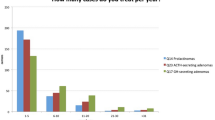Abstract
Nonfunctioning adenomas are the second most common type of pituitary tumor. Over the past few years, our knowledge of the epidemiology, natural history, diagnosis, treatment, and recurrence rates of these tumors has improved. Here, we highlight some of these advances and speculate on future avenues of research. In addition, we describe our own experience in the clinical management of patients with nonfunctioning adenomas. Serum prolactin levels are generally <2,000 mU/l in patients with these tumors; we propose that this level be used as the cut-off to differentiate nonfunctioning from prolactin-secreting adenomas. Despite increases in size in 19% of the microadenomas we studied, none of the patients who received no intervention developed visual complications. By contrast, 50% of untreated macroadenomas enlarged and 67% of affected patients experienced worsened or new visual-field defects. Although most recurrences develop in the first 5 years, recurrence has been reported up 14 years after surgery.
This is a preview of subscription content, access via your institution
Access options
Subscribe to this journal
Receive 12 print issues and online access
$209.00 per year
only $17.42 per issue
Buy this article
- Purchase on Springer Link
- Instant access to full article PDF
Prices may be subject to local taxes which are calculated during checkout


Similar content being viewed by others
References
Ezzat, S. et al. The prevalence of pituitary adenomas: a systematic review. Cancer 101, 613–619 (2004).
Davis, J. R. et al. Pituitary tumours. Reproduction 121, 363–371 (2001).
Nilsson, B., Gustavsson-Kadaka, E., Bengtsson, B.-A. & Jonsson, B. Pituitary adenomas in Sweden between 1958 and 1991: incidence, survival, and mortality. J. Clin. Endocrinol. Metab. 85, 1420–1425 (2000).
Daly, A. F. et al. High prevalence of pituitary adenomas: a cross-sectional study in the province of Liege, Belgium. J. Clin. Endocrinol. Metab. 91, 4769–4775 (2006).
Fernandez, A. et al. High prevalence of pituitary adenomas: a community-based study in the city of Banbury. Presented at the British Endocrine Society meeting (2008).
Karavitaki, N. et al. Do the limits of serum prolactin in disconnection hyperprolactinaemia need re-definition? A study of 226 patients with histologically verified non-functioning pituitary macroadenoma. Clin. Endocrinol. (Oxf.) 65, 524–529 (2006).
Reincke, M. et al. The 'incidentaloma' of the pituitary gland. Is neurosurgery required? JAMA 263, 2772–2776 (1990).
Dekkers, O. M. et al. Observation alone after transsphenoidal surgery for nonfunctioning pituitary macroadenoma. J. Clin. Endocrinol. Metab. 91, 1796–1801 (2006).
Karavitaki, N. et al. What is the natural history of nonoperated nonfunctioning pituitary adenomas? Clin. Endocrinol. (Oxf.) 67, 938–943 (2007).
Gittoes, N. et al. Radiotherapy for non-functioning pituitary tumours. Clin. Endocrinol. (Oxf.) 48, 331–337 (1998).
Brada, M. et al. Risk of second brain tumour after conservative surgery and radiotherapy for pituitary adenoma. BMJ 304, 1343–1346 (1992).
Turner, H. E., Stratton, I. M., Byrne, J. V., Adams, C. B. & Wass, J. H. Audit of selected patients with nonfunctioning pituitary adenomas treated without irradiation—a follow-up study. Clin. Endocrinol. (Oxf.) 51, 281–284 (1999).
Allen, K. & Wass, J. A. H. Prolonged post-operative follow-up is necessary for unirradiated non-functioning pituitary adenomata. Presented at the European Congress of Endocrinology (2006).
Bradley, K. J., Wass, J. A. & Turner, H. E. Non-functioning pituitary adenomas with positive immunoreactivity for ACTH behave more aggressively than ACTH immunonegative tumours but do not recur more frequently. Clin. Endocrinol. (Oxf.) 58, 59–64 (2003).
Renner, U. et al. Heterogeneous dopamine D2 receptor subtype messenger ribonucleic acid expression in clinically nonfunctioning pituitary adenomas. J. Clin. Endocrinol. Metab. 83, 1368–1375 (1998).
Pivonello, R. et al. Dopamine receptor expression and function in clinically nonfunctioning pituitary tumors: comparison with the effectiveness of cabergoline treatment. J. Clin. Endocrinol. Metab. 89, 1674–1683 (2004).
Greenman, Y. et al. Postoperative treatment of clinically nonfunctioning pituitary adenomas with dopamine agonists decreases tumour remnant growth. Clin. Endocrinol. (Oxf.) 63, 39–44 (2005).
Saveanu, A. & Jaquet, P. Somatostatin-dopamine ligands in the treatment of pituitary adenomas. Rev. Endocr. Metab. Disord. 10, 83–90 (2009).
Colao, A. M. et al. Medical therapy of pituitary adenomas: effects on tumor shrinkage. Rev. Endocr. Metab. Disord. 10, 111–123 (2009).
Colao, A. M. Medical therapy for clinically non-functioning pituitary adenomas. Endocr. Relat. Cancer 15, 905–915 (2008).
Author information
Authors and Affiliations
Corresponding author
Ethics declarations
Competing interests
The authors declare no competing financial interests.
Rights and permissions
About this article
Cite this article
Wass, J., Karavitaki, N. Nonfunctioning pituitary adenomas: the Oxford experience. Nat Rev Endocrinol 5, 519–522 (2009). https://doi.org/10.1038/nrendo.2009.147
Issue Date:
DOI: https://doi.org/10.1038/nrendo.2009.147
This article is cited by
-
Phosphorylation of β-catenin at Serine552 correlates with invasion and recurrence of non-functioning pituitary neuroendocrine tumours
Acta Neuropathologica Communications (2022)
-
Mortality in patients with non-functioning pituitary adenoma
Pituitary (2018)
-
Treatment with octreotide LAR in clinically non-functioning pituitary adenoma: results from a case–control study
Pituitary (2012)
-
Stroke and carotid occlusion by giant non-hemorrhagic pituitary adenoma
Acta Neurochirurgica (2011)



